Encyclopedia of Southern Jewish Communities - Tyler, Texas
Tyler: Historical Overview
Incorporated in 1850 as the seat of Smith County, Tyler initially attracted slave-owning planters who flocked to the Confederate cause. These early white settlers and Tyler itself struggled to regain their bearings after the war and emancipation. When major railroads bypassed Tyler in the early 1870s, it seemed the town would be fated to remain a rural backwater. Finally, in 1874, the Houston and Great Northern Railroad built a line into Tyler. By the 1880s, Tyler had emerged as a regional railroad center, with several companies building machine shops in town. Tyler became the commercial center of the East Texas cotton economy, as the cash crop was bought, sold, processed, and shipped in the growing town, which almost tripled its population between 1880 and 1890.
It’s no coincidence that organized Jewish life developed in Tyler during the boom decade of the 1880s. According to rabbi and amateur historian Henry Cohen, there were Jews living in Tyler in the antebellum period, with some even fighting for the Southern side. Yet Jews did not establish any semblance of a community until the 1880s, when a handful of Jewish immigrants set up shop in the burgeoning town.
It’s no coincidence that organized Jewish life developed in Tyler during the boom decade of the 1880s. According to rabbi and amateur historian Henry Cohen, there were Jews living in Tyler in the antebellum period, with some even fighting for the Southern side. Yet Jews did not establish any semblance of a community until the 1880s, when a handful of Jewish immigrants set up shop in the burgeoning town.
Stories of the Jewish Community in Tyler
Early Settlers
Max Rosenfeld was among the first, opening a dry goods store in Tyler by the late 1870s. His cousin, Jacob Lipstate, came to Tyler to work in the store, and later took over the business. Like Rosenfeld and Lipstate, most of these early Jewish settlers were Germany immigrants who opened dry goods or general merchandise stores. A handful also came from Russian Poland, including Moses Pitluk, George Hyman, and Isaac Friedlander, all of whom owned stores in the 1880s.
Max Rosenfeld was among the first, opening a dry goods store in Tyler by the late 1870s. His cousin, Jacob Lipstate, came to Tyler to work in the store, and later took over the business. Like Rosenfeld and Lipstate, most of these early Jewish settlers were Germany immigrants who opened dry goods or general merchandise stores. A handful also came from Russian Poland, including Moses Pitluk, George Hyman, and Isaac Friedlander, all of whom owned stores in the 1880s.
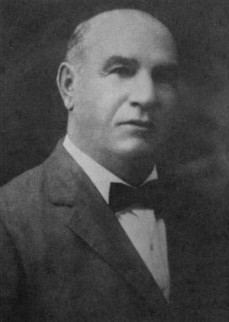 Alexander Golenternek
Alexander Golenternek
Organized Jewish Life in Tyler
This influx of Jews led to efforts to establish religious institutions. Jews first worshipped together at the local Odd Fellows Hall. In 1884, Hyman Liebreich, Abe Harris, and Jacob Lipstate purchased land for a Jewish cemetery. The Jewish community was growing fast during this decade. By 1887, 53 Jewish men established Congregation Beth El; though most lived in Tyler, a handful of the founding members lived in other towns. Later that year, the fledgling congregation bought land for a synagogue on the corner of South College and University Place. Completed in 1889, Temple Beth El’s quick construction reflected the sudden emergence of Tyler’s Jewish community. At its dedication, Rabbi E.M. Chapman of Dallas’ Temple Emanu El led the service.
During Beth El’s first decade, Reform and more traditional Jews co-existed within the congregation, though there was conflict over service styles and religious rituals. One compromise reached in 1895 was that the more traditional prayer book Minhag Jastrow would be used for High Holiday services while the Reform Hebrew Union Prayer Book would be used the rest of the year. Also, in Beth El’s original constitution, Jews married to Gentiles were not allowed to join the congregation, while members who married outside of the faith would have their membership revoked; this restriction was lifted in a new constitution written in 1902. By 1895, Beth El’s board had begun to discuss affiliating with the Reform Union of American Hebrew Congregations.
This influx of Jews led to efforts to establish religious institutions. Jews first worshipped together at the local Odd Fellows Hall. In 1884, Hyman Liebreich, Abe Harris, and Jacob Lipstate purchased land for a Jewish cemetery. The Jewish community was growing fast during this decade. By 1887, 53 Jewish men established Congregation Beth El; though most lived in Tyler, a handful of the founding members lived in other towns. Later that year, the fledgling congregation bought land for a synagogue on the corner of South College and University Place. Completed in 1889, Temple Beth El’s quick construction reflected the sudden emergence of Tyler’s Jewish community. At its dedication, Rabbi E.M. Chapman of Dallas’ Temple Emanu El led the service.
During Beth El’s first decade, Reform and more traditional Jews co-existed within the congregation, though there was conflict over service styles and religious rituals. One compromise reached in 1895 was that the more traditional prayer book Minhag Jastrow would be used for High Holiday services while the Reform Hebrew Union Prayer Book would be used the rest of the year. Also, in Beth El’s original constitution, Jews married to Gentiles were not allowed to join the congregation, while members who married outside of the faith would have their membership revoked; this restriction was lifted in a new constitution written in 1902. By 1895, Beth El’s board had begun to discuss affiliating with the Reform Union of American Hebrew Congregations.
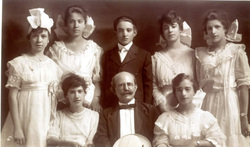 Beth El's 1915 Confirmation Class
Beth El's 1915 Confirmation Class
Unhappy with the congregation’s movement toward Reform, more traditional members left in 1897, meeting at the local Woodman’s Hall. By 1898, they had established Congregation Ahavath Achim, which was officially chartered five years later. Alexander Golenternek, who had moved to Tyler with his wife Sarah by 1895, was the leader of this breakaway group. In the Orthodox congregation’s early years, Golenternek would keep its Torah in his home, carrying it to the rented room each week for services. He was also the congregation’s first president, serving from 1898 to 1906, and again from 1914 to 1928. Despite this split, there were still amicable relations between Tyler’s two Jewish congregations. In fact, five of Ahavath Achim’s 13 charter members also belonged to Beth El in 1910. Beth El’s longtime rabbi, who had been raised Orthodox, would attend the second day of Rosh Hashanah services at Ahavath Achim, where he would be honored with an aliyah.
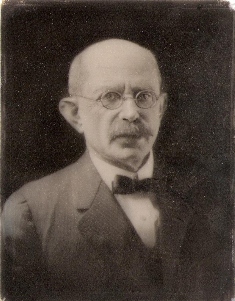 Rabbi Maurice Faber
Rabbi Maurice Faber
Ahavath Achim built a modest, wooden synagogue in 1910 and was able to afford a full-time spiritual leader, S. Smolensky, who also acted as teacher and kosher butcher, though he was not an ordained rabbi. The synagogue had religious school classrooms and a mikvah (ritual bath) in the back of the building. Their Hebrew school met every week day afternoon. Ahavath Achim also acquired its own cemetery. Its members were Orthodox, with the congregation maintaining a shochet (kosher butcher) for its first 50 years so members could follow the kosher dietary laws. Jews from other towns in the area would come to Tyler to purchase kosher meat. Yet since most members of the congregation owned retail stores, they were unable to avoid working on Saturdays, though they always closed for the High Holidays.
After the split, Beth El was free to embrace Reform Judaism, although a new rabbi would play a leading role in this process. When Beth El looked for a full-time spiritual leader in 1900, they advertised for a “conservative rabbi.” They hired Maurice Faber, a Hungarian immigrant, who was serving a congregation in Keokuk, Iowa. Although he had been raised in an Orthodox home, Rabbi Faber was an ardent reformer, and within a year of his hiring, yarmulkes had been banned and confirmation replaced the bar mitzvah ritual. Beth El finally joined the Union of American Hebrew Congregations in 1907. Faber was very engaged in the larger community, leading the effort to build a public library in Tyler. He convinced the Lipstate family to put together a group that donated land for the building, and got funding from the Carnegie Foundation to construct a two-story library. Faber served on the library board for 18 years.
After the split, Beth El was free to embrace Reform Judaism, although a new rabbi would play a leading role in this process. When Beth El looked for a full-time spiritual leader in 1900, they advertised for a “conservative rabbi.” They hired Maurice Faber, a Hungarian immigrant, who was serving a congregation in Keokuk, Iowa. Although he had been raised in an Orthodox home, Rabbi Faber was an ardent reformer, and within a year of his hiring, yarmulkes had been banned and confirmation replaced the bar mitzvah ritual. Beth El finally joined the Union of American Hebrew Congregations in 1907. Faber was very engaged in the larger community, leading the effort to build a public library in Tyler. He convinced the Lipstate family to put together a group that donated land for the building, and got funding from the Carnegie Foundation to construct a two-story library. Faber served on the library board for 18 years.
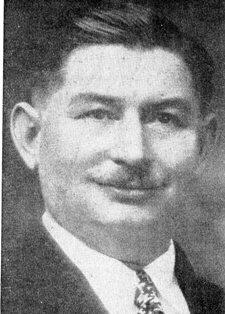 Sam Roosth
Sam Roosth
By 1910, Beth El had 54 members, seven of whom lived in towns outside of Tyler, like Lufkin and Longview. Of those who lived in Tyler, only 18% were born in the United States; 44% of the foreign-born members came from Germany, while 42% came from Russia or Poland. Most had been in the United States for several decades, with their average year of immigration being 1882. The large majority of Beth El members, 79%, owned their own businesses, with most operating dry goods or grocery stores; the remaining 21% were store clerks or traveling salesmen. Only 8% were in skilled manual trades, which included a tailor, baker, and farmer. The founding members of Ahavath Achim were similarly concentrated in retail trade. Of the 13 founding members in 1903, 77% owned their own businesses, most commonly grocery, dry goods, or furniture stores. Each of the founders was foreign-born, with 77% from Russia, Poland, or Galicia; only one was German. Thus the Orthodox members of Ahavath Achim were more likely to come from Eastern Europe, although Beth El also had several members from there as well.
Tyler Jews also established other Jewish organizations. Both congregations had Sisterhoods, and there were also local chapters of B’nai B’rith and the National Council of Jewish Women. In 1906, local Zionists founded the Ahavath Zion Society, which quickly grew to 35 members, most of whom belonged to Ahavath Achim. In 1915, Alexander Golenternek and Henry Heffler founded the Tyler Zionist District, which was affiliated with the Zionist Organization of America. When Heffler died in 1922, the chapter was renamed in his memory. In 1920, Tyler women established a chapter of Hadassah, which eventually drew members from both congregations.
-
The Jewish Community in Tyler Today
Tyler has flourished in the years since World War II. The city has developed new industry, including petroleum, chemical, and metal plants. Israel Smith left his legal career to become the president of a local metal foundry after the war. By the mid-1960s, Tyler had 125 manufacturing plants. In recent decades, Tyler has become the educational and medical center for East Texas, with several hospitals and University of Texas at Tyler, which grew from 3,725 students in 1990 to over 6,000 in 2010. Tyler’s population exploded from 58,000 people in 1970 to an estimated 108,000 in 2008.
Interestingly, this tremendous growth has not had much of an effect on the Jewish community, which shrunk over the last few decades of the 20th century, from 500 people in 1968 to about 400 in 1997. The reason for this anomaly is that Jews in Tyler, for the most part, are no longer involved in retail trade. Whereas a century ago, Tyler’s growth attracted Jewish merchants who catered to the increasing numbers of people living in the city, today, few Jews are looking for places in which to open stores. Indeed, the rise of chain discount stores and malls has transformed the retail industry, with little economic opportunity for small store owners. Today, most Jews prefer to live in larger cities. Many of the children raised in Tyler in the 1950s, 60s, and 70s moved away to larger cities after college, often entering the professions. In the 21st century, most of the children growing up in Tyler do not plan to remain to the city when they are older.
Despite these trends, Tyler’s Jewish community has remained stable due to the slow but steady influx of professionals, often associated with the local medical center or university. Dr. Ben Fisch was one of the early Jewish medical professionals in Tyler, creating the city’s allergy clinic. Dr. Fisch made a fortune through investing in a local cable television company, and used this largesse to support, often anonymously, many institutions around the area, including UT-Tyler.
Tyler still has two Jewish congregations, which have both flourished over the last few decades. Rabbi Kalman Taxon led Ahavath Achim from 1961 to around 1990. During his tenure, women were counted toward the minyan and allowed to read from the Torah. After Taxon, Ahavath Achim has had a series of rabbis, including Avi Perets and Alan Learner. After Rabbi Wessel retired in 1970, Beth El had several rabbis, including Jeffrey Ballon, Eugene Levy, and Steve Gold. From 1998 to 2003, Beth El did not have a full-time rabbi, but has had consistent rabbinical leadership since 2003. Both congregations built new synagogues. Ahavath Achim moved to a new building on Donnybrook Avenue in 1982, while Temple Beth El constructed a new synagogue in 1987, the same year the congregation celebrated its centennial.
Today, both congregations are relatively small: in 2010, Beth El had about 85 families, while Ahavath Achim had between 50 and 60. In the 1970s, the two congregations decided to merge their religious schools due to their declining numbers. In 2010, there were about 25 students in the combined school. There were even discussions about merging the Reform and Conservative congregations in the 1990s, but they could not agree on a kosher kitchen and other issues of ritual. Though it continues to be divided into two congregations, Tyler’s Jewish community remains strong. While it might not be growing, the city’s recent development bodes well for the community’s future.
Tyler Jews also established other Jewish organizations. Both congregations had Sisterhoods, and there were also local chapters of B’nai B’rith and the National Council of Jewish Women. In 1906, local Zionists founded the Ahavath Zion Society, which quickly grew to 35 members, most of whom belonged to Ahavath Achim. In 1915, Alexander Golenternek and Henry Heffler founded the Tyler Zionist District, which was affiliated with the Zionist Organization of America. When Heffler died in 1922, the chapter was renamed in his memory. In 1920, Tyler women established a chapter of Hadassah, which eventually drew members from both congregations.
-
The Jewish Community in Tyler Today
Tyler has flourished in the years since World War II. The city has developed new industry, including petroleum, chemical, and metal plants. Israel Smith left his legal career to become the president of a local metal foundry after the war. By the mid-1960s, Tyler had 125 manufacturing plants. In recent decades, Tyler has become the educational and medical center for East Texas, with several hospitals and University of Texas at Tyler, which grew from 3,725 students in 1990 to over 6,000 in 2010. Tyler’s population exploded from 58,000 people in 1970 to an estimated 108,000 in 2008.
Interestingly, this tremendous growth has not had much of an effect on the Jewish community, which shrunk over the last few decades of the 20th century, from 500 people in 1968 to about 400 in 1997. The reason for this anomaly is that Jews in Tyler, for the most part, are no longer involved in retail trade. Whereas a century ago, Tyler’s growth attracted Jewish merchants who catered to the increasing numbers of people living in the city, today, few Jews are looking for places in which to open stores. Indeed, the rise of chain discount stores and malls has transformed the retail industry, with little economic opportunity for small store owners. Today, most Jews prefer to live in larger cities. Many of the children raised in Tyler in the 1950s, 60s, and 70s moved away to larger cities after college, often entering the professions. In the 21st century, most of the children growing up in Tyler do not plan to remain to the city when they are older.
Despite these trends, Tyler’s Jewish community has remained stable due to the slow but steady influx of professionals, often associated with the local medical center or university. Dr. Ben Fisch was one of the early Jewish medical professionals in Tyler, creating the city’s allergy clinic. Dr. Fisch made a fortune through investing in a local cable television company, and used this largesse to support, often anonymously, many institutions around the area, including UT-Tyler.
Tyler still has two Jewish congregations, which have both flourished over the last few decades. Rabbi Kalman Taxon led Ahavath Achim from 1961 to around 1990. During his tenure, women were counted toward the minyan and allowed to read from the Torah. After Taxon, Ahavath Achim has had a series of rabbis, including Avi Perets and Alan Learner. After Rabbi Wessel retired in 1970, Beth El had several rabbis, including Jeffrey Ballon, Eugene Levy, and Steve Gold. From 1998 to 2003, Beth El did not have a full-time rabbi, but has had consistent rabbinical leadership since 2003. Both congregations built new synagogues. Ahavath Achim moved to a new building on Donnybrook Avenue in 1982, while Temple Beth El constructed a new synagogue in 1987, the same year the congregation celebrated its centennial.
Today, both congregations are relatively small: in 2010, Beth El had about 85 families, while Ahavath Achim had between 50 and 60. In the 1970s, the two congregations decided to merge their religious schools due to their declining numbers. In 2010, there were about 25 students in the combined school. There were even discussions about merging the Reform and Conservative congregations in the 1990s, but they could not agree on a kosher kitchen and other issues of ritual. Though it continues to be divided into two congregations, Tyler’s Jewish community remains strong. While it might not be growing, the city’s recent development bodes well for the community’s future.
 Rabbi Wessel leads a Tu B'shvat program
Rabbi Wessel leads a Tu B'shvat program at Beth El in the 1950s. Photo courtesy of Temple Beth El.
The Oil Boom
Tyler and its Jewish community were transformed after oil was discovered in the nearby East Texas oil field in 1930. This discovery and the ensuing boom turned an agricultural market and railroad town into a bustling city in which oil fueled the economy. Between 1910 and 1940, Tyler’s population tripled. On the eve of World War II, 30,000 people lived in the city. This growth benefited the local Jewish community, as the oil boom attracted Jewish merchants and those who wished to try their luck in the oil business. Tyler’s Jewish population grew from 350 Jews in 1919 to 650 in 1937.
Polish-born Sam Roosth came to Tyler in 1910, opening a bakery. In 1924, he started a dry goods store in town. After oil was discovered, Roosth decided to seek his own fortune looking for black gold. In 1933 he partnered with another Jewish immigrant, Aleck Genecov, who owned a store in Corsicana. The two started the Roosth and Genecov Production Company, which grew into a very successful oil business. Genecov moved his family to Tyler in 1935. Both the Roosth and Genecov families diversified their holdings, buying cattle ranches and real estate in Tyler.
Generations of Roosths and Genecovs have worked in the family business and have had a huge impact on both Tyler and its Jewish community. Aleck Genecov, who served as the longtime president of the company, was head of the Tyler Jewish Welfare Fund and belonged to both congregations. He served on several local bank and hospital boards and supported many charitable causes. Both Sam Roosth and Genecov were strong supporters of Israel, raising lots of money to aid the fledgling Jewish state. Genecov received the Tower of David Award from Israel in 1969. Sam’s son Isidore Roosth joined the operation in 1934, and became one of Tyler’s most prominent business and civic leaders. He served on the Texas Board of Health and on the boards of local hospitals, universities, and numerous local charities. He was also president of Ahavath Achim and the local B’nai B’rith chapter. Today, Sam Roosth, the grandson of the founder, runs the Roosth Production Company, which is still in the oil and gas exploration business. His cousin, Steve Roosth, runs the real estate side of the family business. Today, the Genecov Group is an independent company involved in both real estate and oil & gas investments. Following in a long tradition of Roosths and Genecovs, Sam Roosth has been a major philanthropist and supporter of local charitable causes, especially the United Way. In 2000, the Roosth family endowed a chair in the College of Education and Psychology at the University of Texas at Tyler.
The East Texas oil boom greatly benefited Tyler’s congregations. Temple Beth El went from having 48 members in 1922, which was actually fewer than their number of founding members 35 years earlier, to 87 members in 1947. In order to hold its growing number of families, the congregation built a new synagogue in 1938 on the corner of Shaw and Augusta Streets. Burnett Wadel led Beth El during this period of expansion, serving as president from 1922 to 1944. In 1957, Beth El added a religious school annex with additional classrooms to accommodate the baby boom generation. Rabbi Harvey Wessel guided the congregation from 1939 to 1970. The long tenures of Rabbis Faber and Wessel brought a great measure of stability to the congregation during this period of growth.
Ahavath Achim experienced similar growth and stability. Rabbi Aaron Moscovitz, a native of Hungary, led the congregation from 1924 to 1943. By the early 1940s, the congregation had outgrown its small synagogue, and bought an old theater, which they converted into a house of worship. Ahavath Achim enjoyed the financial support of several of Tyler’s successful oilmen, who helped fund this acquisition and remodeling. Ike Rudman and his wife donated the money for a recreation center in the new synagogue, while Alec and Hilda Genecov gave the classrooms on the building’s second floor. By 1949, the Orthodox congregation had 82 member families. The members of Ahavath Achim were extremely close-knit, with several extended families and lots of marriages between them. By the 1950s, the second generation immigrant members of the congregation pushed for a more Americanized version of Judaism, leading Ahavath Achim to introduce mixed-gender seating, more English prayers, and the confirmation ceremony; in 1956, the congregation officially joined the Conservative movement
Tyler and its Jewish community were transformed after oil was discovered in the nearby East Texas oil field in 1930. This discovery and the ensuing boom turned an agricultural market and railroad town into a bustling city in which oil fueled the economy. Between 1910 and 1940, Tyler’s population tripled. On the eve of World War II, 30,000 people lived in the city. This growth benefited the local Jewish community, as the oil boom attracted Jewish merchants and those who wished to try their luck in the oil business. Tyler’s Jewish population grew from 350 Jews in 1919 to 650 in 1937.
Polish-born Sam Roosth came to Tyler in 1910, opening a bakery. In 1924, he started a dry goods store in town. After oil was discovered, Roosth decided to seek his own fortune looking for black gold. In 1933 he partnered with another Jewish immigrant, Aleck Genecov, who owned a store in Corsicana. The two started the Roosth and Genecov Production Company, which grew into a very successful oil business. Genecov moved his family to Tyler in 1935. Both the Roosth and Genecov families diversified their holdings, buying cattle ranches and real estate in Tyler.
Generations of Roosths and Genecovs have worked in the family business and have had a huge impact on both Tyler and its Jewish community. Aleck Genecov, who served as the longtime president of the company, was head of the Tyler Jewish Welfare Fund and belonged to both congregations. He served on several local bank and hospital boards and supported many charitable causes. Both Sam Roosth and Genecov were strong supporters of Israel, raising lots of money to aid the fledgling Jewish state. Genecov received the Tower of David Award from Israel in 1969. Sam’s son Isidore Roosth joined the operation in 1934, and became one of Tyler’s most prominent business and civic leaders. He served on the Texas Board of Health and on the boards of local hospitals, universities, and numerous local charities. He was also president of Ahavath Achim and the local B’nai B’rith chapter. Today, Sam Roosth, the grandson of the founder, runs the Roosth Production Company, which is still in the oil and gas exploration business. His cousin, Steve Roosth, runs the real estate side of the family business. Today, the Genecov Group is an independent company involved in both real estate and oil & gas investments. Following in a long tradition of Roosths and Genecovs, Sam Roosth has been a major philanthropist and supporter of local charitable causes, especially the United Way. In 2000, the Roosth family endowed a chair in the College of Education and Psychology at the University of Texas at Tyler.
The East Texas oil boom greatly benefited Tyler’s congregations. Temple Beth El went from having 48 members in 1922, which was actually fewer than their number of founding members 35 years earlier, to 87 members in 1947. In order to hold its growing number of families, the congregation built a new synagogue in 1938 on the corner of Shaw and Augusta Streets. Burnett Wadel led Beth El during this period of expansion, serving as president from 1922 to 1944. In 1957, Beth El added a religious school annex with additional classrooms to accommodate the baby boom generation. Rabbi Harvey Wessel guided the congregation from 1939 to 1970. The long tenures of Rabbis Faber and Wessel brought a great measure of stability to the congregation during this period of growth.
Ahavath Achim experienced similar growth and stability. Rabbi Aaron Moscovitz, a native of Hungary, led the congregation from 1924 to 1943. By the early 1940s, the congregation had outgrown its small synagogue, and bought an old theater, which they converted into a house of worship. Ahavath Achim enjoyed the financial support of several of Tyler’s successful oilmen, who helped fund this acquisition and remodeling. Ike Rudman and his wife donated the money for a recreation center in the new synagogue, while Alec and Hilda Genecov gave the classrooms on the building’s second floor. By 1949, the Orthodox congregation had 82 member families. The members of Ahavath Achim were extremely close-knit, with several extended families and lots of marriages between them. By the 1950s, the second generation immigrant members of the congregation pushed for a more Americanized version of Judaism, leading Ahavath Achim to introduce mixed-gender seating, more English prayers, and the confirmation ceremony; in 1956, the congregation officially joined the Conservative movement

Jewish Businesses in Tyler
Although some were active in the oil industry, most Tyler Jews remained in retail trade and continued to dominate the city’s downtown square into the 1950s. Phil Hurwitz owned one of Tyler’s finest men’s clothing stores for several decades, before selling it in the 1980s. John Regan established a chain of 25 women’s clothing stores called Regan’s.
Perhaps the most unique Jewish-owned business grew out of a small smokehouse Sam Greenberg built in 1937 to prepare kosher geese for his family. Greenberg was the son of S.I. Greenberg, who was the first service leader and shochet at Ahavath Achim. When others began to bring their own birds to Greenberg for him to smoke, he realized that his smokehouse could become a viable business. By the 1940s, Greenberg was selling his smoked turkeys to growing numbers of customers. His son Zelick Greenberg joined the business and turned it into a major operation. Each Christmas, Greenberg Turkeys would ship 100,000 smoked turkeys to customers around the country. The company, now run by Zelick’s son Sam Greenberg and Tracy Lisner, remains in operation, still using the original recipe developed by Sam and Selma Greenberg in the 1930s. The company has even moved into the Internet age, at www.gobblegobble.com.
If Greenberg Turkeys are a Christmas institution for many in East Texas, so is Ralph Davis’ Christmas Store. Davis originally owned a dress shop in downtown Tyler in the 1940s. He later sold the store and went into the dress manufacturing business. Davis then opened a fine gifts store, R.L. Davis, which became Tyler’s answer to Tiffany’s. Later, he and his wife Judy opened the Christmas Store, which drew customers from around the region with their designer ornaments and special-themed Christmas trees.
Jewish Life in Tyler
As The Christmas Store attests, Tyler Jews have fit themselves into the local culture. By and large, they have been well received, facing minimal anti-Semitism. In contrast to many other cities, Jews were always welcome at the local country club. From their prominent economic position in the city, several Jews became civic leaders. Two Tyler Jews have been elected mayor of the city, Jerry Nasits, who served from 1958 to 1960, and Norman Shtofman, who was in office in 1982 and 1983. Others, such as John Regan, have served on the city council. Some Tyler Jews were prominent in the arts, including Joseph Kirshbaum, who served as director and conductor of the East Texas Symphony Orchestra from 1950 until he retired in 1978.
Although some were active in the oil industry, most Tyler Jews remained in retail trade and continued to dominate the city’s downtown square into the 1950s. Phil Hurwitz owned one of Tyler’s finest men’s clothing stores for several decades, before selling it in the 1980s. John Regan established a chain of 25 women’s clothing stores called Regan’s.
Perhaps the most unique Jewish-owned business grew out of a small smokehouse Sam Greenberg built in 1937 to prepare kosher geese for his family. Greenberg was the son of S.I. Greenberg, who was the first service leader and shochet at Ahavath Achim. When others began to bring their own birds to Greenberg for him to smoke, he realized that his smokehouse could become a viable business. By the 1940s, Greenberg was selling his smoked turkeys to growing numbers of customers. His son Zelick Greenberg joined the business and turned it into a major operation. Each Christmas, Greenberg Turkeys would ship 100,000 smoked turkeys to customers around the country. The company, now run by Zelick’s son Sam Greenberg and Tracy Lisner, remains in operation, still using the original recipe developed by Sam and Selma Greenberg in the 1930s. The company has even moved into the Internet age, at www.gobblegobble.com.
If Greenberg Turkeys are a Christmas institution for many in East Texas, so is Ralph Davis’ Christmas Store. Davis originally owned a dress shop in downtown Tyler in the 1940s. He later sold the store and went into the dress manufacturing business. Davis then opened a fine gifts store, R.L. Davis, which became Tyler’s answer to Tiffany’s. Later, he and his wife Judy opened the Christmas Store, which drew customers from around the region with their designer ornaments and special-themed Christmas trees.
Jewish Life in Tyler
As The Christmas Store attests, Tyler Jews have fit themselves into the local culture. By and large, they have been well received, facing minimal anti-Semitism. In contrast to many other cities, Jews were always welcome at the local country club. From their prominent economic position in the city, several Jews became civic leaders. Two Tyler Jews have been elected mayor of the city, Jerry Nasits, who served from 1958 to 1960, and Norman Shtofman, who was in office in 1982 and 1983. Others, such as John Regan, have served on the city council. Some Tyler Jews were prominent in the arts, including Joseph Kirshbaum, who served as director and conductor of the East Texas Symphony Orchestra from 1950 until he retired in 1978.
The Jewish Community in Tyler Today
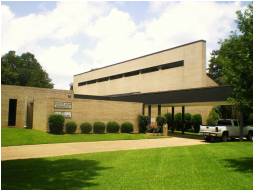 Ahavath Achim
Ahavath Achim
Tyler has flourished in the years since World War II. The city has developed new industry, including petroleum, chemical, and metal plants. Israel Smith left his legal career to become the president of a local metal foundry after the war. By the mid-1960s, Tyler had 125 manufacturing plants. In recent decades, Tyler has become the educational and medical center for East Texas, with several hospitals and University of Texas at Tyler, which grew from 3,725 students in 1990 to over 6,000 in 2010. Tyler’s population exploded from 58,000 people in 1970 to an estimated 108,000 in 2008.
Interestingly, this tremendous growth has not had much of an effect on the Jewish community, which shrunk over the last few decades of the 20th century, from 500 people in 1968 to about 400 in 1997. The reason for this anomaly is that Jews in Tyler, for the most part, are no longer involved in retail trade. Whereas a century ago, Tyler’s growth attracted Jewish merchants who catered to the increasing numbers of people living in the city, today, few Jews are looking for places in which to open stores. Indeed, the rise of chain discount stores and malls has transformed the retail industry, with little economic opportunity for small store owners. Today, most Jews prefer to live in larger cities. Many of the children raised in Tyler in the 1950s, 60s, and 70s moved away to larger cities after college, often entering the professions. In the 21st century, most of the children growing up in Tyler do not plan to remain to the city when they are older.
Interestingly, this tremendous growth has not had much of an effect on the Jewish community, which shrunk over the last few decades of the 20th century, from 500 people in 1968 to about 400 in 1997. The reason for this anomaly is that Jews in Tyler, for the most part, are no longer involved in retail trade. Whereas a century ago, Tyler’s growth attracted Jewish merchants who catered to the increasing numbers of people living in the city, today, few Jews are looking for places in which to open stores. Indeed, the rise of chain discount stores and malls has transformed the retail industry, with little economic opportunity for small store owners. Today, most Jews prefer to live in larger cities. Many of the children raised in Tyler in the 1950s, 60s, and 70s moved away to larger cities after college, often entering the professions. In the 21st century, most of the children growing up in Tyler do not plan to remain to the city when they are older.
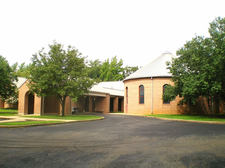 Temple Beth El
Temple Beth El
Despite these trends, Tyler’s Jewish community has remained stable due to the slow but steady influx of professionals, often associated with the local medical center or university. Dr. Ben Fisch was one of the early Jewish medical professionals in Tyler, creating the city’s allergy clinic. Dr. Fisch made a fortune through investing in a local cable television company, and used this largesse to support, often anonymously, many institutions around the area, including UT-Tyler.
Tyler still has two Jewish congregations, which have both flourished over the last few decades. Rabbi Kalman Taxon led Ahavath Achim from 1961 to around 1990. During his tenure, women were counted toward the minyan and allowed to read from the Torah. After Taxon, Ahavath Achim has had a series of rabbis, including Avi Perets and Alan Learner. After Rabbi Wessel retired in 1970, Beth El had several rabbis, including Jeffrey Ballon, Eugene Levy, and Steve Gold. From 1998 to 2003, Beth El did not have a full-time rabbi, but has had consistent rabbinical leadership since 2003; Rabbi Neal Katz served as their student rabbi 2000-2002 and has been rabbinic leader there from 2003 to the present. Both congregations built new synagogues. Ahavath Achim moved to a new building on Donnybrook Avenue in 1982, while Temple Beth El constructed a new synagogue in 1987, the same year the congregation celebrated its centennial.
Today, both congregations are relatively small: in 2010, Beth El had about 85 families, while Ahavath Achim had between 50 and 60. In the 1970s, the two congregations decided to merge their religious schools due to their declining numbers. In 2010, there were about 25 students in the combined school. There were even discussions about merging the Reform and Conservative congregations in the 1990s, but they could not agree on a kosher kitchen and other issues of ritual. Though it continues to be divided into two congregations, Tyler’s Jewish community remains strong. While it might not be growing, the city’s recent development bodes well for the community’s future.
Tyler still has two Jewish congregations, which have both flourished over the last few decades. Rabbi Kalman Taxon led Ahavath Achim from 1961 to around 1990. During his tenure, women were counted toward the minyan and allowed to read from the Torah. After Taxon, Ahavath Achim has had a series of rabbis, including Avi Perets and Alan Learner. After Rabbi Wessel retired in 1970, Beth El had several rabbis, including Jeffrey Ballon, Eugene Levy, and Steve Gold. From 1998 to 2003, Beth El did not have a full-time rabbi, but has had consistent rabbinical leadership since 2003; Rabbi Neal Katz served as their student rabbi 2000-2002 and has been rabbinic leader there from 2003 to the present. Both congregations built new synagogues. Ahavath Achim moved to a new building on Donnybrook Avenue in 1982, while Temple Beth El constructed a new synagogue in 1987, the same year the congregation celebrated its centennial.
Today, both congregations are relatively small: in 2010, Beth El had about 85 families, while Ahavath Achim had between 50 and 60. In the 1970s, the two congregations decided to merge their religious schools due to their declining numbers. In 2010, there were about 25 students in the combined school. There were even discussions about merging the Reform and Conservative congregations in the 1990s, but they could not agree on a kosher kitchen and other issues of ritual. Though it continues to be divided into two congregations, Tyler’s Jewish community remains strong. While it might not be growing, the city’s recent development bodes well for the community’s future.
